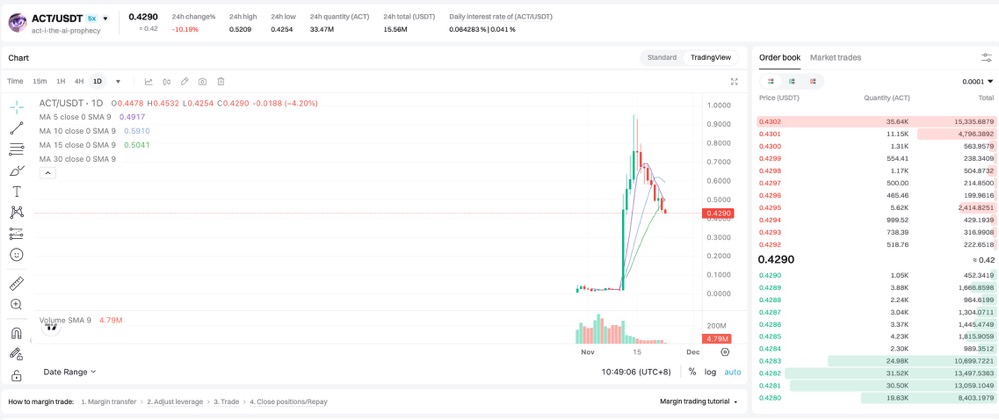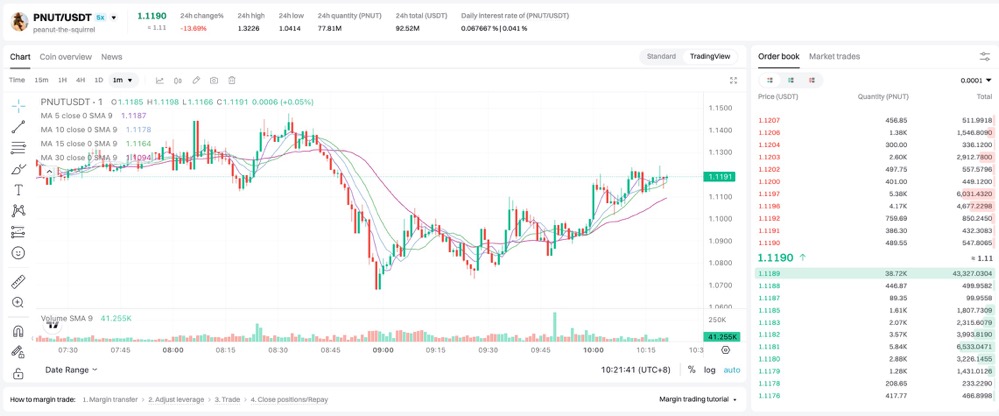Bitget: Top 4 in global daily trading volume!
Please also display BTC in AR62.77%
New listings on Bitget : Pi Network
BTC/USDT$79621.38 (+5.88%)Fear at Greed Index24(Extreme fear)
Altcoin season index:0(Bitcoin season)
Coins listed in Pre-MarketBABY,PAWS,WCTTotal spot Bitcoin ETF netflow -$103.9M (1D); -$362.1M (7D).Welcome gift package para sa mga bagong user na nagkakahalaga ng 6200 USDT.Claim now
Trade anumang oras, kahit saan gamit ang Bitget app. I-download ngayon
Bitget: Top 4 in global daily trading volume!
Please also display BTC in AR62.77%
New listings on Bitget : Pi Network
BTC/USDT$79621.38 (+5.88%)Fear at Greed Index24(Extreme fear)
Altcoin season index:0(Bitcoin season)
Coins listed in Pre-MarketBABY,PAWS,WCTTotal spot Bitcoin ETF netflow -$103.9M (1D); -$362.1M (7D).Welcome gift package para sa mga bagong user na nagkakahalaga ng 6200 USDT.Claim now
Trade anumang oras, kahit saan gamit ang Bitget app. I-download ngayon
Bitget: Top 4 in global daily trading volume!
Please also display BTC in AR62.77%
New listings on Bitget : Pi Network
BTC/USDT$79621.38 (+5.88%)Fear at Greed Index24(Extreme fear)
Altcoin season index:0(Bitcoin season)
Coins listed in Pre-MarketBABY,PAWS,WCTTotal spot Bitcoin ETF netflow -$103.9M (1D); -$362.1M (7D).Welcome gift package para sa mga bagong user na nagkakahalaga ng 6200 USDT.Claim now
Trade anumang oras, kahit saan gamit ang Bitget app. I-download ngayon

May kaugnayan sa coin
Price calculator
Kasaysayan ng presyo
Paghula ng presyo
Teknikal na pagsusuri
Gabay sa pagbili ng coin
kategorya ng Crypto
Profit calculator

Achain presyoACT
Hindi naka-list
Quote pera:
PHP
Kinukuha ang data mula sa mga third-party na provider. Ang pahinang ito at ang impormasyong ibinigay ay hindi nag-eendorso ng anumang partikular na cryptocurrency. Gustong i-trade ang mga nakalistang barya? Click here
₱0.07331-0.56%1D
Price chart
Last updated as of 2025-04-08 07:26:42(UTC+0)
Market cap:--
Ganap na diluted market cap:--
Volume (24h):--
24h volume / market cap:0.00%
24h high:₱0.07383
24h low:₱0.07323
All-time high:₱79.62
All-time low:₱0.01329
Umiikot na Supply:-- ACT
Total supply:
1,000,000,000ACT
Rate ng sirkulasyon:0.00%
Max supply:
1,000,000,000ACT
Price in BTC:0.{7}1610 BTC
Price in ETH:0.{6}8142 ETH
Price at BTC market cap:
--
Price at ETH market cap:
--
Mga kontrata:--
Ano ang nararamdaman mo tungkol sa Achain ngayon?
Tandaan: Ang impormasyong ito ay para sa sanggunian lamang.
Presyo ng Achain ngayon
Ang live na presyo ng Achain ay ₱0.07331 bawat (ACT / PHP) ngayon na may kasalukuyang market cap na ₱0.00 PHP. Ang 24 na oras na dami ng trading ay ₱0.00 PHP. Ang presyong ACT hanggang PHP ay ina-update sa real time. Ang Achain ay -0.56% sa nakalipas na 24 na oras. Mayroon itong umiikot na supply ng 0 .
Ano ang pinakamataas na presyo ng ACT?
Ang ACT ay may all-time high (ATH) na ₱79.62, na naitala noong 2018-01-10.
Ano ang pinakamababang presyo ng ACT?
Ang ACT ay may all-time low (ATL) na ₱0.01329, na naitala noong 2024-07-28.
Bitcoin price prediction
Kailan magandang oras para bumili ng ACT? Dapat ba akong bumili o magbenta ng ACT ngayon?
Kapag nagpapasya kung buy o mag sell ng ACT, kailangan mo munang isaalang-alang ang iyong sariling diskarte sa pag-trading. Magiiba din ang aktibidad ng pangangalakal ng mga long-term traders at short-term traders. Ang Bitget ACT teknikal na pagsusuri ay maaaring magbigay sa iyo ng sanggunian para sa trading.
Ayon sa ACT 4 na teknikal na pagsusuri, ang signal ng kalakalan ay Sell.
Ayon sa ACT 1d teknikal na pagsusuri, ang signal ng kalakalan ay Malakas na nagbebenta.
Ayon sa ACT 1w teknikal na pagsusuri, ang signal ng kalakalan ay Malakas na nagbebenta.
Ano ang magiging presyo ng ACT sa 2026?
Batay sa makasaysayang modelo ng hula sa pagganap ng presyo ni ACT, ang presyo ng ACT ay inaasahang aabot sa ₱0.08464 sa 2026.
Ano ang magiging presyo ng ACT sa 2031?
Sa 2031, ang presyo ng ACT ay inaasahang tataas ng +11.00%. Sa pagtatapos ng 2031, ang presyo ng ACT ay inaasahang aabot sa ₱0.1909, na may pinagsama-samang ROI na +160.73%.
Achain price history (PHP)
The price of Achain is -26.41% over the last year. The highest price of in PHP in the last year was ₱0.2715 and the lowest price of in PHP in the last year was ₱0.01329.
TimePrice change (%) Lowest price
Lowest price Highest price
Highest price 
 Lowest price
Lowest price Highest price
Highest price 
24h-0.56%₱0.07323₱0.07383
7d-15.93%₱0.07323₱0.08759
30d-14.30%₱0.05900₱0.09888
90d-45.16%₱0.05863₱0.1335
1y-26.41%₱0.01329₱0.2715
All-time-99.46%₱0.01329(2024-07-28, 254 araw ang nakalipas )₱79.62(2018-01-10, 7 taon na ang nakalipas )
Achain impormasyon sa merkado
Achain's market cap history
Achain holdings by concentration
Whales
Investors
Retail
Achain addresses by time held
Holders
Cruisers
Traders
Live coinInfo.name (12) price chart

Achain na mga rating
Mga average na rating mula sa komunidad
4.6
Ang nilalamang ito ay para sa mga layuning pang-impormasyon lamang.
ACT sa lokal na pera
1 ACT To MXN$0.031 ACT To GTQQ0.011 ACT To CLP$1.271 ACT To UGXSh4.761 ACT To HNLL0.031 ACT To ZARR0.021 ACT To TNDد.ت01 ACT To IQDع.د1.681 ACT To TWDNT$0.041 ACT To RSDдин.0.141 ACT To DOP$0.081 ACT To MYRRM0.011 ACT To GEL₾01 ACT To UYU$0.051 ACT To MADد.م.0.011 ACT To AZN₼01 ACT To OMRر.ع.01 ACT To SEKkr0.011 ACT To KESSh0.171 ACT To UAH₴0.05
- 1
- 2
- 3
- 4
- 5
Last updated as of 2025-04-08 07:26:42(UTC+0)
Achain balita

Meta Gorgonite: Bakit ang potensyal ng $ACT ay malayo pa sa katapusan
推特观点精选•2024-11-23 02:50

Sun at Moon Xiao Chu: Bakit patuloy akong nagdadagdag ng posisyon sa pag-pullback ng $PNUT at $ACT?
Twitter Opinion Selection•2024-11-23 02:24
![Dapat Basahin Ngayon | Mga Itinatampok na Tanawin sa Twitter [Nobyembre 22]](https://img.bgstatic.com/multiLang/web/8e1199d7822fef00d2ec95133764186d.png)
Dapat Basahin Ngayon | Mga Itinatampok na Tanawin sa Twitter [Nobyembre 22]
Renata•2024-11-22 09:22
![Dapat Basahin Ngayon | Mga Itinatampok na Tanawin sa Twitter [Nobyembre 18]](https://img.bgstatic.com/multiLang/web/8e1199d7822fef00d2ec95133764186d.png)
Dapat Basahin Ngayon | Mga Itinatampok na Tanawin sa Twitter [Nobyembre 18]
Renata•2024-11-18 07:48
New listings on Bitget
New listings
Buy more
Ang mga tao ay nagtatanong din tungkol sa presyo ng Achain.
Ano ang kasalukuyang presyo ng Achain?
The live price of Achain is ₱0.07 per (ACT/PHP) with a current market cap of ₱0 PHP. Achain's value undergoes frequent fluctuations due to the continuous 24/7 activity in the crypto market. Achain's current price in real-time and its historical data is available on Bitget.
Ano ang 24 na oras na dami ng trading ng Achain?
Sa nakalipas na 24 na oras, ang dami ng trading ng Achain ay ₱0.00.
Ano ang all-time high ng Achain?
Ang all-time high ng Achain ay ₱79.62. Ang pinakamataas na presyong ito sa lahat ng oras ay ang pinakamataas na presyo para sa Achain mula noong inilunsad ito.
Maaari ba akong bumili ng Achain sa Bitget?
Oo, ang Achain ay kasalukuyang magagamit sa sentralisadong palitan ng Bitget. Para sa mas detalyadong mga tagubilin, tingnan ang aming kapaki-pakinabang na gabay na Paano bumili ng achain .
Maaari ba akong makakuha ng matatag na kita mula sa investing sa Achain?
Siyempre, nagbibigay ang Bitget ng estratehikong platform ng trading, na may mga matatalinong bot sa pangangalakal upang i-automate ang iyong mga pangangalakal at kumita ng kita.
Saan ako makakabili ng Achain na may pinakamababang bayad?
Ikinalulugod naming ipahayag na ang estratehikong platform ng trading ay magagamit na ngayon sa Bitget exchange. Nag-ooffer ang Bitget ng nangunguna sa industriya ng mga trading fee at depth upang matiyak ang kumikitang pamumuhunan para sa mga trader.
Saan ako makakabili ng crypto?
Video section — quick verification, quick trading

How to complete identity verification on Bitget and protect yourself from fraud
1. Log in to your Bitget account.
2. If you're new to Bitget, watch our tutorial on how to create an account.
3. Hover over your profile icon, click on “Unverified”, and hit “Verify”.
4. Choose your issuing country or region and ID type, and follow the instructions.
5. Select “Mobile Verification” or “PC” based on your preference.
6. Enter your details, submit a copy of your ID, and take a selfie.
7. Submit your application, and voila, you've completed identity verification!
Ang mga investment sa Cryptocurrency, kabilang ang pagbili ng Achain online sa pamamagitan ng Bitget, ay napapailalim sa market risk. Nagbibigay ang Bitget ng madali at convenient paraan para makabili ka ng Achain, at sinusubukan namin ang aming makakaya upang ganap na ipaalam sa aming mga user ang tungkol sa bawat cryptocurrency na i-eooffer namin sa exchange. Gayunpaman, hindi kami mananagot para sa mga resulta na maaaring lumabas mula sa iyong pagbili ng Achain. Ang page na ito at anumang impormasyong kasama ay hindi isang pag-endorso ng anumang partikular na cryptocurrency.
Bitget Insights

Nusrat_Mim_CryptoQue
1h
$SOL
SOLUSDT Market Analysis | 1H Chart Update & Multi-Timeframe Outlook
Current Price: $109.76
24H Change: +7.64%
24H High/Low: $112.99 / $95.23
Volume (24H): 7.97M SOL
Market Snapshot:
After a sharp correction that pulled SOL down to the $95.23 support zone, we’re seeing a strong bounce and continuation to the upside. Currently, SOL is retesting the $110 zone, which acts as both a psychological and technical resistance.
Technical Breakdown (1H Chart):
EMA Analysis:
SOL is trading above the 5, 10, and 20 EMAs, indicating short-term bullish momentum. The EMA(10) and EMA(20) recently crossed, confirming the upside trend continuation.
Parabolic SAR:
Dots are below the price action — a bullish sign confirming upward pressure.
MACD:
MACD line is above the signal line with increasing histogram bars — momentum is picking up.
KDJ Oscillator:
K line is above D and J, suggesting strong buying strength but nearing overbought territory — short-term consolidation may occur.
Volume Surge:
A noticeable increase in volume suggests growing interest and potentially institutional activity near the dip.
Multi-Timeframe Prediction:
1. Short-Term (1H-4H):
If SOL holds above $108 and breaks $112.98, we may see a move toward $116-$119 as the next resistance. RSI and MACD support this potential breakout.
2. Mid-Term (1D):
Watch for a close above the 50-day moving average (not shown here but relevant). If bullish momentum continues, $125-$130 becomes a feasible mid-range target.
3. Long-Term Outlook (1W):
As macro sentiment improves and BTC remains stable, SOL could aim for $150+ in a sustained bullish run, though corrections should be expected along the way.
Personal Insights:
Solana’s recent rebound from $95 is not just a technical bounce — it reflects confidence returning after a strong sell-off. Smart traders are likely to watch for confirmation above $112 with increased volume. Caution is still warranted if SOL dips back below $105.
Final Thought:
This recovery looks promising, but always adapt your strategy to real-time data. Multi-timeframe analysis helps reduce noise and improves decision-making. Let’s keep an eye on key levels and stay ready to act.
BTC+0.57%
MOVE-3.80%

Nusrat_Mim_CryptoQue
2h
$ETH
ETH/USDT Market Analysis | Short-Term Recovery or Just a Bounce?
ETH has shown a notable recovery, currently priced at $1,598.74, up +3.84% in the past 24 hours after dipping to a low of $1,412.00. Let’s break down what’s going on and where this could be headed.
Technical Breakdown (1H Timeframe)
MACD: The MACD line is rising and attempting a bullish crossover, with the histogram flipping green. This is a potential early sign of short-term momentum returning.
KDJ: %K is at 64.71, crossing above %D and %J. Momentum appears to be turning positive, but volatility still lingers.
EMA: Price is currently above the 5, 10, and 20-period EMAs, a sign of bullish short-term structure recovery.
Volume: Volume has picked up slightly, supporting the current move, but not dramatically enough to confirm a strong breakout yet.
SAR: Parabolic SAR dots are below the price, suggesting a shift into bullish territory.
Key Levels to Watch
Support: $1,542 and $1,500 remain critical for maintaining any bullish bias.
Resistance: $1,625 and $1,655 could act as ceilings if ETH continues upward.
Future Outlook (Multi-Timeframe View)
4H Chart Outlook
On the 4-hour chart, ETH still looks oversold, but indicators like MACD and KDJ are starting to flatten. If it can hold above $1,580 and retest $1,625 with volume, we might see momentum shift more clearly to the upside.
Daily Chart Macro View
The daily chart suggests ETH is still in a downtrend channel. Any real reversal would require a break and hold above $1,700+. Otherwise, we could be looking at another lower high forming soon.
SOON-0.76%
MOVE-3.80%
URBestTrader
3h
3 Crypto Trading Secrets You Wish You Knew Earlier
Ever look back at a trade and think, “I knew that was going to happen…”?
The truth is, most missed profits come from ignoring simple strategies that actually work.
Here are 3 underrated trading secrets that can give you an edge—starting today.
1. Trade the Reaction, Not the News
Big news doesn't always mean big profits—because by the time you hear it, whales have already acted.
Wait for the market’s reaction to news—not the headline itself
Let volatility settle, then ride the true direction
Pro tip: Set alerts, not FOMO
2. Learn to Read the Order Book
Price charts show the past—but order books show the future.
Watch for large buy/sell walls—these often act as invisible support/resistance
Sudden wall removals can signal incoming breakouts
Combine with volume for sniper-level entries
3. Stop Chasing Green Candles
Chasing pumps is how most traders donate money to smarter players.
Instead, mark key zones and set limit orders before price gets there
The best trades are boring: planned, not emotional
Remember: no entry is better than a bad entry
You don’t need 10 indicators or complicated setups.
You just need consistency, patience—and a few good tricks that others overlook.
#CryptoTips #CryptoTrading #Bitcoin #AltcoinTrading #TradingSecrets #OrderBook #TradingMindset #BitgetInsights #Scalping #SmartTrading
BITCOIN+0.29%
S-2.93%

Cryptopolitan
3h
Crypto lawyer sues US DHS to uncover Satoshi Nakamoto’s true identity
Crypto attorney James Murphy, also known on X as MetaLawMan, just filed a lawsuit against the U.S. Department of Homeland Security in Washington, D.C., demanding the release of information that could expose the true identity of Satoshi Nakamoto, the unknown figure behind Bitcoin, according to a report by Crypto In America.
James filed the case in D.C. District Court with the help of Brian Field, a former Assistant U.S. Attorney who now focuses on Freedom of Information Act cases. The target is a 2019 public statement made by Rana Saoud, a DHS Special Agent, who claimed during a conference that the U.S. government had already figured out who created Bitcoin.
Rana said the creator wasn’t one person but four individuals, and claimed they were all interviewed by DHS agents in California, where they explained what Bitcoin was and why they made it.
James wants the government to release the identities of those four people. He believes if the U.S. has that kind of information, it shouldn’t be kept secret.
“If the government does indeed have this information, as the DHS Special Agent has claimed, it should not be withheld from the public,” James reportedly said in a statement to Crypto In America.
James pointed out that Bitcoin’s global impact makes this information a public issue, not just a government secret. The lawsuit zeroes in on that 2019 DHS presentation. Rana’s exact words from the event are referenced in the case.
She claimed the agency had both identified and located the creators of Bitcoin, had interviewed them in California, and had heard directly from them about the development and reasons behind it. Despite that claim, DHS has never publicly confirmed those interviews or revealed any of the names.
James says he’s hoping for cooperation under the current Trump administration, which promised more openness from federal agencies. He’s appealing to DHS Secretary Kristi Noem, saying she could choose to hand over the information now, without dragging the case through a long court process.
“My hope is that Secretary Noem will embrace transparency in this instance and share this information voluntarily,” James said. “However, if she does not, we are prepared to pursue this litigation as far as necessary to solve this mystery.”
He made it clear he’s willing to go the distance to get the answer. James is not the first to try and uncover who Satoshi is, but this time it’s a legal fight, not just speculation or online theories.
Some in the crypto community have supported the effort, while others believe finding out who Satoshi is could destroy the appeal of Bitcoin—which was built to be free from central control.
The community remains split. Some believe knowing Satoshi’s identity would bring clarity, while others say it could threaten Bitcoin’s decentralized status. If these four creators are real, still alive, and have access to early wallets or private keys, then a major chunk of Bitcoin could technically be controlled. That would punch a hole in everything Bitcoin was supposed to stand for.
Cryptopolitan Academy: Coming Soon - A New Way to Earn Passive Income with DeFi in 2025. Learn More
WHY-0.82%
PEOPLE-3.07%

Crypto-Ticker
4h
Will Nike Survive or Go Bankrupt?
The U.S. retail sector is reeling from the aftershocks of President Donald Trump's bold Liberation Day tariffs , but no brand has been hit harder than Nike. With a staggering 46% reciprocal tariff slapped on Vietnamese goods—a country that manufactures half of all Nike footwear—the iconic sportswear brand finds itself in a precarious position. Investors and consumers alike are now asking the same question: Can Nike survive this, or is it facing a financial reckoning that could spiral into bankruptcy?
Nike’s deep reliance on Vietnam is no secret. According to the company’s own 2024 annual report , 50% of its footwear and 28% of its apparel production came from the Southeast Asian nation. Vietnam's strategic advantages—low labor costs, efficient shipping routes, and a skilled workforce—have made it a manufacturing darling for global brands.
But that dependence has now turned into vulnerability. The newly imposed 46% tariff instantly inflates Nike’s production costs, destabilizing its entire supply chain overnight. Unlike competitors like Adidas, which relies on Vietnam for a smaller portion of its inventory (39% footwear and 18% apparel), Nike is disproportionately exposed to the fallout, making the blow far more severe.
At 5:06 PM New York time on April 3, Nike’s shares nosedived 6.4% in extended trading, according to Bloomberg. The decline wasn’t an anomaly—it was the tipping point after weeks of selling pressure. Nike stock had already fallen 20% in March, largely due to weak earnings and growing competition from newer brands like Hoka and On, which are chipping away at Nike’s market share with innovation-focused strategies.
This week's tariff announcement hit Nike at its weakest moment. The company’s Chief Financial Officer had already warned of continued revenue declines, and the market was listening. The reaction wasn’t isolated either—Shenzhou International, a major supplier to Nike, saw its stock plunge 18% in Hong Kong, its worst crash in over three years. The message from the market is clear: confidence is fading fast.
While it’s premature to declare Nike on the brink of bankruptcy, the threat is no longer unthinkable. The company is now trapped in a financial bind. Higher tariffs mean ballooning costs that will likely be passed on to American consumers, just as the National Retail Federation warned. But raising prices risks further alienating a consumer base already exploring fresher, trendier alternatives.
Nike may be forced to overhaul its supply chain, diversify manufacturing away from Vietnam, and cut costs aggressively. This could involve factory relocations, downsizing, or cancellation of expansion plans—all of which are expensive and time-consuming. The only thing more expensive than adapting, however, would be standing still.
Trump’s tariff move seems less about Nike specifically and more about targeting Vietnam’s massive $123.5 billion trade surplus with the U.S. Once viewed as the ideal alternative to China, Vietnam is now being portrayed as the new "bad actor" in Trump’s protectionist agenda. In his 2019 remarks, Trump accused Vietnam of being “worse than China” in terms of trade exploitation—a narrative he appears determined to revive.
Vietnam’s leadership scrambled for damage control, with Prime Minister Pham Minh Chinh even humorously offering to “golf all day” with Trump at Mar-a-Lago. Despite easing taxes on U.S. goods and approving Starlink service as goodwill gestures, the country couldn’t avoid the crosshairs. The tariffs came anyway—and with them, a looming crisis for Vietnam’s economy and for brands that bet big on its factories.
The rest of 2025 could make or break Nike. With its stock in freefall, revenues projected to drop, and costs skyrocketing, Nike will need to act fast. This could mean pivoting to domestic manufacturing, renegotiating supplier contracts, or absorbing short-term losses to preserve long-term brand equity.
Still, there are wildcards. If Trump’s tariff enforcement stalls—as former U.S. Commerce Secretary predicts—or if trade negotiations resume, Nike may find breathing room. But hoping for political reversals isn’t a business strategy. Nike needs to restructure now or risk a prolonged period of market irrelevance —or worse, financial collapse.
Nike isn’t going bankrupt tomorrow, but the storm is very real. The combination of weak earnings, intense new competition, and geopolitical exposure to Vietnam’s tariffs has turned a blue-chip stock into a risk asset overnight. If management fails to adapt swiftly, Nike could go from global icon to cautionary tale.
In the end, this isn’t just about shoes. It’s about whether one of America’s most recognized brands can navigate the new world order of trade wars, tariffs, and consumer disruption. The next few quarters will tell us if Nike is still built to last—or if it’s running out of time.
The U.S. retail sector is reeling from the aftershocks of President Donald Trump's bold Liberation Day tariffs , but no brand has been hit harder than Nike. With a staggering 46% reciprocal tariff slapped on Vietnamese goods—a country that manufactures half of all Nike footwear—the iconic sportswear brand finds itself in a precarious position. Investors and consumers alike are now asking the same question: Can Nike survive this, or is it facing a financial reckoning that could spiral into bankruptcy?
Nike’s deep reliance on Vietnam is no secret. According to the company’s own 2024 annual report , 50% of its footwear and 28% of its apparel production came from the Southeast Asian nation. Vietnam's strategic advantages—low labor costs, efficient shipping routes, and a skilled workforce—have made it a manufacturing darling for global brands.
But that dependence has now turned into vulnerability. The newly imposed 46% tariff instantly inflates Nike’s production costs, destabilizing its entire supply chain overnight. Unlike competitors like Adidas, which relies on Vietnam for a smaller portion of its inventory (39% footwear and 18% apparel), Nike is disproportionately exposed to the fallout, making the blow far more severe.
At 5:06 PM New York time on April 3, Nike’s shares nosedived 6.4% in extended trading, according to Bloomberg. The decline wasn’t an anomaly—it was the tipping point after weeks of selling pressure. Nike stock had already fallen 20% in March, largely due to weak earnings and growing competition from newer brands like Hoka and On, which are chipping away at Nike’s market share with innovation-focused strategies.
This week's tariff announcement hit Nike at its weakest moment. The company’s Chief Financial Officer had already warned of continued revenue declines, and the market was listening. The reaction wasn’t isolated either—Shenzhou International, a major supplier to Nike, saw its stock plunge 18% in Hong Kong, its worst crash in over three years. The message from the market is clear: confidence is fading fast.
While it’s premature to declare Nike on the brink of bankruptcy, the threat is no longer unthinkable. The company is now trapped in a financial bind. Higher tariffs mean ballooning costs that will likely be passed on to American consumers, just as the National Retail Federation warned. But raising prices risks further alienating a consumer base already exploring fresher, trendier alternatives.
Nike may be forced to overhaul its supply chain, diversify manufacturing away from Vietnam, and cut costs aggressively. This could involve factory relocations, downsizing, or cancellation of expansion plans—all of which are expensive and time-consuming. The only thing more expensive than adapting, however, would be standing still.
Trump’s tariff move seems less about Nike specifically and more about targeting Vietnam’s massive $123.5 billion trade surplus with the U.S. Once viewed as the ideal alternative to China, Vietnam is now being portrayed as the new "bad actor" in Trump’s protectionist agenda. In his 2019 remarks, Trump accused Vietnam of being “worse than China” in terms of trade exploitation—a narrative he appears determined to revive.
Vietnam’s leadership scrambled for damage control, with Prime Minister Pham Minh Chinh even humorously offering to “golf all day” with Trump at Mar-a-Lago. Despite easing taxes on U.S. goods and approving Starlink service as goodwill gestures, the country couldn’t avoid the crosshairs. The tariffs came anyway—and with them, a looming crisis for Vietnam’s economy and for brands that bet big on its factories.
The rest of 2025 could make or break Nike. With its stock in freefall, revenues projected to drop, and costs skyrocketing, Nike will need to act fast. This could mean pivoting to domestic manufacturing, renegotiating supplier contracts, or absorbing short-term losses to preserve long-term brand equity.
Still, there are wildcards. If Trump’s tariff enforcement stalls—as former U.S. Commerce Secretary predicts—or if trade negotiations resume, Nike may find breathing room. But hoping for political reversals isn’t a business strategy. Nike needs to restructure now or risk a prolonged period of market irrelevance —or worse, financial collapse.
Nike isn’t going bankrupt tomorrow, but the storm is very real. The combination of weak earnings, intense new competition, and geopolitical exposure to Vietnam’s tariffs has turned a blue-chip stock into a risk asset overnight. If management fails to adapt swiftly, Nike could go from global icon to cautionary tale.
In the end, this isn’t just about shoes. It’s about whether one of America’s most recognized brands can navigate the new world order of trade wars, tariffs, and consumer disruption. The next few quarters will tell us if Nike is still built to last—or if it’s running out of time.
ORDER+1.25%
PRIME+1.99%
Mga kaugnay na asset
Mga sikat na cryptocurrencies
Isang seleksyon ng nangungunang 8 cryptocurrencies ayon sa market cap.
Kamakailang idinagdag
Ang pinakahuling idinagdag na cryptocurrency.
Maihahambing na market cap
Sa lahat ng asset ng Bitget, ang 8 na ito ang pinakamalapit sa Achain sa market cap.




































Achain Social Data
Sa nakalipas na 24 na oras, ang marka ng sentimento ng social media para sa Achain ay 3, at ang trend ng presyo ng social media patungo sa Achain ay Bullish. Ang overall na marka ng social media ng Achain ay 0, na nagra-rank ng 846 sa lahat ng cryptocurrencies.
Ayon sa LunarCrush, sa nakalipas na 24 na oras, binanggit ang mga cryptocurrencies sa social media nang 1,058,120 (na) beses, na binanggit ang Achain na may frequency ratio na 0%, na nagra-rank ng 1081 sa lahat ng cryptocurrencies.
Sa nakalipas na 24 na oras, mayroong total 13 na natatanging user na tumatalakay sa Achain, na may kabuuang Achain na pagbanggit ng 1. Gayunpaman, kumpara sa nakaraang 24 na oras, ang bilang ng mga natatanging user bumaba ng 0%, at ang kabuuang bilang ng mga pagbanggit ay bumaba ng 0%.
Sa Twitter, mayroong kabuuang 0 na tweet na nagbabanggit ng Achain sa nakalipas na 24 na oras. Kabilang sa mga ito, ang 0% ay bullish sa Achain, 0% ay bearish sa Achain, at ang 100% ay neutral sa Achain.
Sa Reddit, mayroong 0 na mga post na nagbabanggit ng Achain sa nakalipas na 24 na oras. Kung ikukumpara sa nakaraang 24 na oras, ang bilang ng mga pagbanggit bumaba ng 0% . Bukod pa rito, mayroong 0 na komento na nagbabanggit ng Achain. Kung ikukumpara sa nakaraang 24 na oras, ang bilang ng mga pagbanggit ay bumaba ng 0%.
Lahat ng panlipunang pangkalahatang-ideya
3